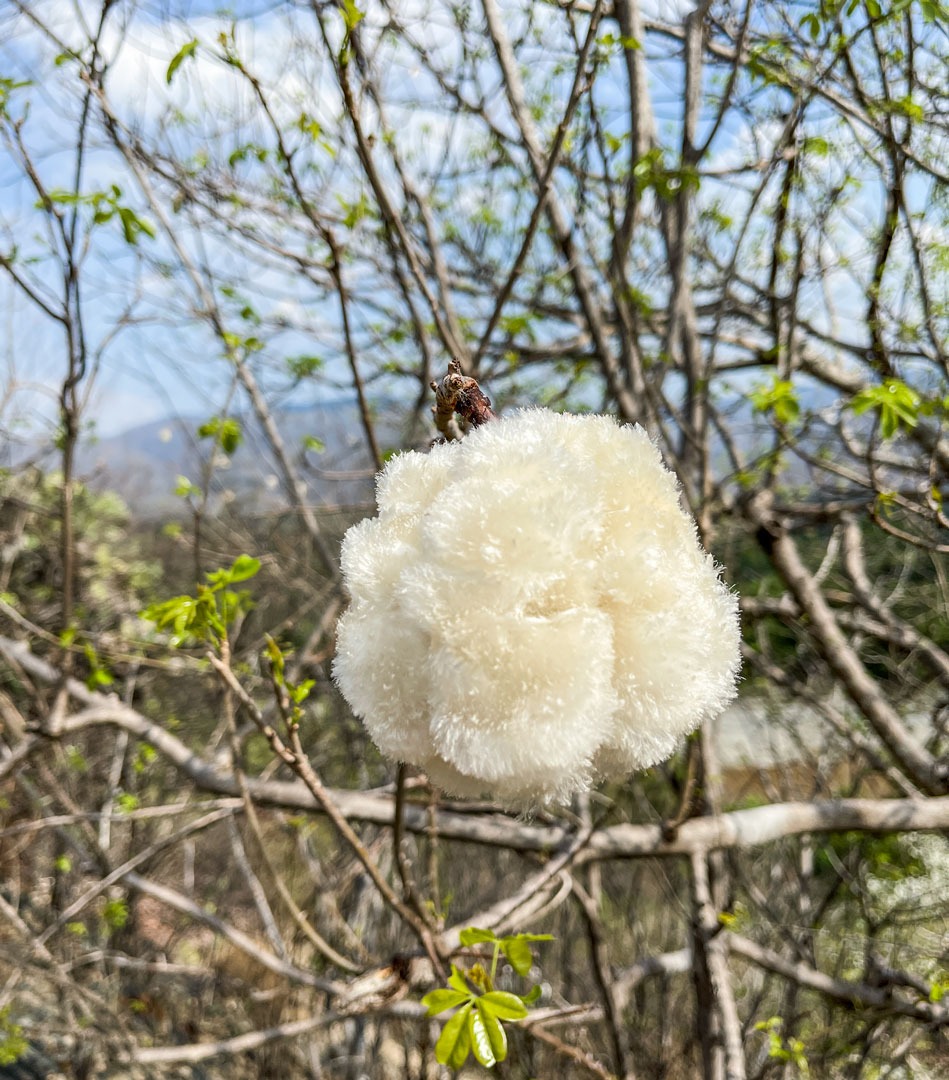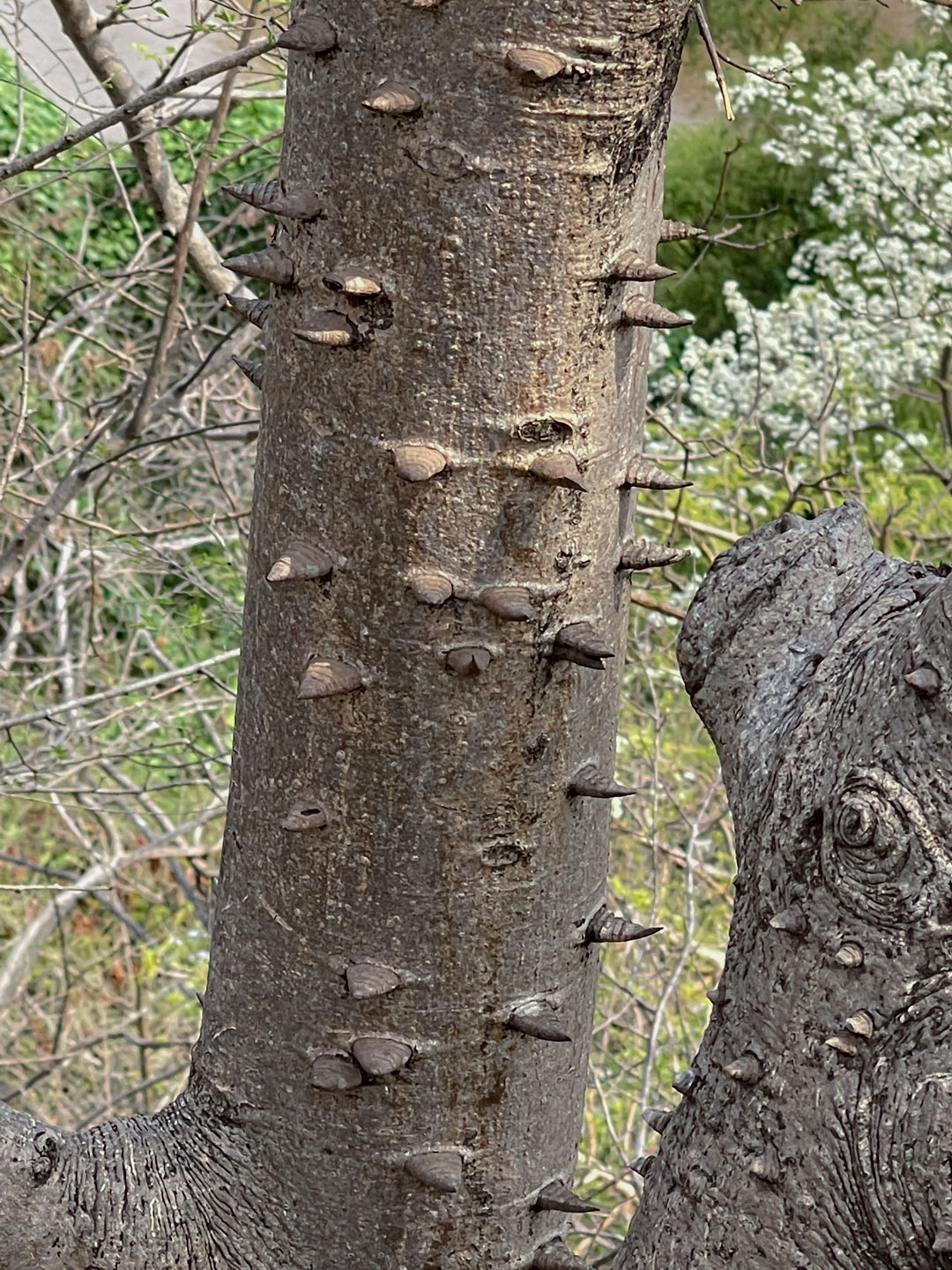Ceiba Ascuosifolia photographed by Maria Alejandra Gutierrez, FLAAR Mesoamerica.
The Ceiba occurs naturally from southern Mexico to southeastern Brazil (including the Antilles) and in western Africa. As the species C. aesculifolia, C. insignis and C. speciosa occurs in Central and / or South America, many researchers agree that the ceiba is native to America. The fact that it is also found in Africa may be for two reasons: the first is that it was carried by humans during the first trips between the two continents and the second is that the seeds were transported naturally by air or sea, this The latter is supported by a recent genetic comparison, linked to the discovery of fossil pollen in 13,000-year-old sediments in Ghana (Mari, 2015).
C. aesculifolia is commonly called Pochote, Algodoncillo or Ceibillo in Guatemala. What is interesting about this beautiful Ceiba is its medical properties. For example, the bark is used in traditional medicine in San Rafael, Coxcatlán, Puebla for the treatment of diabetes, kidney maladies, tumors, gastritis, and wounds Canales et al., 2005, 2006). The cotton-like fiber from the fruit can be applied to wounds for healing purpose, according to (Rodriguez, et al, 2013), this is related with the sterols, flavonoids, phenolic compounds, fatty acids and esters that contains the fiber and acts as synergists for antimicrobial activity, especially against fungal strains.
You can learn more with this helpful bibliography we have prepared for you.
PDF, Articles, Books on Ceiba aesculifolia
- 2007
- Caracterización de un hongo asociado a la planta macho del Pochote (Ceiba aesculifolia (H.B.& K.) Britten & Baker f. subsp. Parvifolia (Rose) P.E. Gibbs&Semir) en Tehuacán-Cuicatlán, México. Agrociencia. Vol. 42, No. 2. Pages 205-215.
Available Online:
www.scielo.org.mx/pdf/agro/v42n2/v42n2a8.pdf
- 2000
- Flora del Bajío y de regiones adyacentes. Fascículo 90. INECOL. 13 pages.
Available Online:
www1.inecol.edu.mx/publicaciones/resumeness/FLOBA/Flora%2090.pdf
- 2013
- Desempeño de tres especies arbóreas del bosque tropical caducifolio en un ensayo de restauración ecológica. Botanical Sciences. Vol. 91, No. 1. Pages 107-114.
Available Online:
www.scielo.org.mx/pdf/bs/v91n1/v91n1a9.pdf
- 2016
- Antimicrobial activity of the fiber produced by “Pochote” Ceiba aesculifolia subsp. Parvifolia. Afr. J. Tradit. Complement Altern Med. Vol. 13, No. 3. Pages 44-53.
Available Online:
http://journals.sfu.ca/africanem/index.php/ajtcam/article/view/3825/2383
- 2003
- Revisión taxonómica del género Ceiba Mill. (Bombacaceae). Anales Jard. Bot. Madrid. Vol. 60, No. 2. Pages 259-300.
Available Online:
https://dialnet.unirioja.es/descarga/articulo/762476.pdf
- 2015
- El árbol de ceiba. Ediciones Digitales. 37 pages.
Available Online:
http://edicionesdigitales.info/ceiba/ceiba.pdf
- 2013
- Flora de Guerrero, Bombacaceae. No. 54. Universidad Nacional Autónoma de México. 33 pages.
Available Online:
http://biologia.fciencias.unam.mx/plantasvasculares/PDF%20FLORAS/54%20Bombacaceae.pdf
- 2013
- Evaluation of some medicinal properties of Ceiba aesculifolia subsp. Parvifolia. Journal of Medicinal Plants Research. Vol. 7, No. 7. Pages 309-314.
Available Online:
www.researchgate.net/profile/Julieta_Orozco/publication/274780298_Evaluation_of_some_medicinal_properties_of_Ceiba_aesculifolia_subsp_parvifolia/links/5529d0160cf2e089a3a7eb3b/Evaluation-of-some-medicinal-properties-of-Ceiba-aesculifolia-subsp-parvifolia.pdf
- 2004
- Effects of forest fragmentation on pollinator activity and consequences for plant reproductive success and mating patterns in bat-pollinated Bombacaceous trees. Biotropica. Vol. 36, No. 2. Pages 131-138.
Available Online:
www.mda.cinvestav.mx/personal_eco/profesores/Munguia/Quesadaetal2004.pdf
- 2004
- Estudio morfológico de plántulas de la familia Bombacaceae en Quintana Roo, México. Foresta Veracruzana. Vol. 6, No. 2. Pages 1-6.
Available Online:
www.redalyc.org/pdf/497/49760201.pdf
- 2017
- Morphological variation in fruits and seeds of Ceiba aesculifolia and its relationship with germination and seedling biomass. Botanical Sciences. Vol. 95, No. 1. Pages 81-91.
Available Online:
www.botanicalsciences.com.mx/index.php/botanicalSciences/article/view/636/pdf_2
Suggested webpages with photos and information on Ceiba aesculifolia
www.tropical.theferns.info/viewtropical.php?id=Ceiba+aesculifolia
Information and photos.
https://ecojardinunam.wordpress.com/2014/09/01/conoce-a-la-pochota-ceiba-aesculifolia/
Information and photos.
www.uaq.mx/FCN/naturaleza/Ceiba%20asecutifolia.php
Information.
www.cicy.mx/sitios/flora%20digital/ficha_virtual.php?especie=1744
Information.
www.backyardnature.net/yucatan/pochete.htm
Information and photos.
www.medicinatradicionalmexicana.unam.mx/monografia.php?l=3&t=&id=7933
Medicinal information.
Updated June 30, 2021.
First posted November, 2017















































































